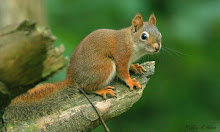As many of you know, Bruce and I are currently in the process of building what will someday be a permanent residence for us in northwest Indiana. What I find so appealing about our 21 acres is that this property landscape is rich with habitats that support a wide variety of birds and wildlife.
The front area of our property used to be a Christmas tree farm, thus we have an abundance of different types of evergreen trees. American Goldfinches, Black-capped Chickadees and Ruby-throated Hummingbirds are often seen in these trees. We also have a large grassland/prairie area favored by Eastern Bluebirds, American Robins and Chipping Sparrows. Shrubs and forests edge the grassy areas where Tufted Titmice, Red-bellied Woodpeckers, Northern Cardinals, and White and Red-breasted Nuthatches flit freely about.
The middle area of our acreage is mostly forested with deciduous and coniferous trees. There is also a lovely meadow filled with wildflowers which is frequented by beautiful butterflies, various sparrows and flycatchers, White-tailed Deer and Woodchucks.
The back end of our land edges a cattailed-filled marsh. Sandhill Cranes, Great Blue Herons, Green Herons, Red-tailed Hawks, beavers and various turtles can be seen in this thriving wetland area. It's no wonder why we have chosen to build a home on this stunning piece of land.
Below I feature birds recently seen on our beautiful country property.
Yellow Warbler ~ These golden beauties fill the marsh in May. They can also be seen foraging in shrubs, bushes and trees.
Male common Yellowthroat ~ These sightly birds are seen close to the ground, often hiding amid marsh vegetation.
Blue-gray Gnatcatcher ~ I most often see these tiny, active birds feeding near the tips of tree branches in the forest.
Eastern Bluebirds can be seen perched above the grassy areas of our property on electric wires, posts and tree limbs. This male bluebird and his mate chose to raise a family in one of the eight nest boxes on our property. The healthy brood of four recently fledged and can be seen begging for food from mom and dad in the locust grove area.
The young bluebird on the left is an offspring of the male bluebird in the previous photograph. This little bird seemed fascinated by the Indigo Bunting perched on the same branch. Currently, this bunting sings his little heart out all day long in the locust trees.
Swamp Sparrow ~ I frequently see these pretty birds feeding at the water's edge of the marsh
House Wren ~ A most loquacious bird seen on low branches at the forest edge. These tiny, aggressive birds compete with Eastern Bluebirds for ownership of nest boxes.
I have seen American Goldfinches in the marsh, forest and grassland areas of our property. Their swooping flight pattern and cheerful warbles always brighten my day.
Like the goldfinch above, I have observed Gray Catbirds on all areas of our acreage. Catbird tunes are especially exuberant and spirited including sharp whistles, high pitched squeaks, cat-like mews and imitations of other bird vocalizations.
I regularly see Brown Thrashers belting out a tune on the highest point of many of the pine trees on our land, though I see them feeding on the ground. Like the catbird previously mentioned, Brown Thrashers mimic songs from other birds. They have quite the extensive repertoire!
Eastern Towhee ~ These vocal birds are frequently seen along the woodland edges or feeding on the ground. They seem to sing from higher perches, though.
Female Red-winged Blackbird ~ Red-winged Blackbirds are quite abundant in the marsh at the back of our acreage.
Baltimore Oriole ~ I'm always delighted to see these radiant birds on all areas of our property
This Eastern Phoebe has chosen to make her nest inside our house (currently in the process of being built). She and her mate scoped out the house for 2 1/2 weeks while Bruce and his carpenters were framing it. Fortunately, the pair chose the inside of the garage for a nesting sight. This will be the last area completed. Surprisingly, the phoebes don't seem to mind the constant din of Skilsaws, drills and hammering. What a perfect spot, free from gusty winds and rainfall. The young phoebes hatched recently as Bruce spotted the parents bringing insects to the nest. On a side note, If you look closely, you can see the nest is made of moss, grass and dog fur. I hung an old, empty suet cake feeder and filled it with dog fur from Honey and Bear (both Akita/Husky/German Shepherd mixes). The female phoebe emptied the feeder of downy fur and now her nestlings are resting comfortably on a fluffy, cozy contribution from Honey and Bear.
~ Update ~
Bruce positioned a ladder so he could get a good look at the Eastern Phoebe nest. This is what he found! He was kind enough to take a photograph for me using his phone.





















